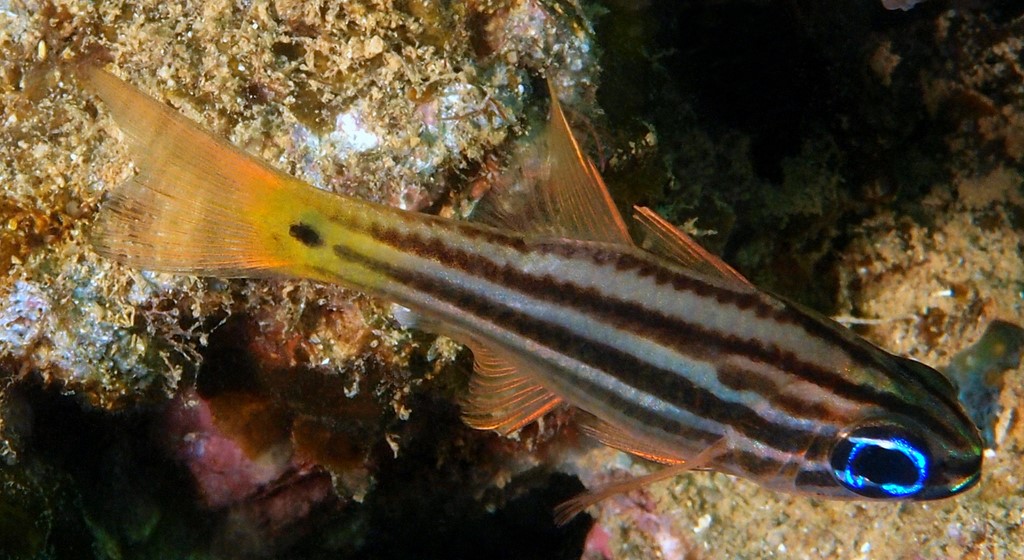OSTORHINCHUS COMPRESSUS - (SMITH & RADCLIFFE, 1911)
Actinopterygii (Gigaclass) > Actinopteri (Class) > Teleostei (Subclass) > Gobiiformes (Order) > Apogonoidei (Suborder) > Apogonidae (Family) > Apogoninae (Subfamily) > Ostorhinchus (Genus)
Poisson cardinal aux yeux bleus, Apogon aux yeux bleus, Blue-eye cardinalfish, Blue-eyed cardinal, Blue-eye cardinalfish, Ochre-striped cardinalfish, Split-banded cardinalfish, Hira-tenjikudai, ヒラテンジクダイ, 裂帶天竺鯛,
Synonymes
Amia compressa (Smith & Radcliffe, 1911)
Apogon compressus (Smith & Radcliffe, 1911)
Apogonichthys macrophthalmus (Bleeker, 1860)
--------------------------
Description
Dorsal spines (total): 8; Dorsal soft rays (total): 9; Anal spines: 2; Anal soft rays: 9; Pectoral fin rays: 13-14; Lateral line scales: 23-25; Gill rakers: 7-8 (usually: 7) + 20-22 (usually: 21). Body strongly compressed. Max. length: 12.0 cm TL, common length: 8.5 cm SL. Depth range: 2 - 20 m.
Color
Brown-striped body with electric blue eyes, six reddish-brown stripes along the sides, and 3-4 'spots' on the tail base. The broad stripe on the upper side is divided behind the eye. Small juveniles have a black spot in the middle of a yellow caudal peduncle.
Etymology
Ostorhinchus: from Greek, osteon = bone + from Greek, rhynchos = beak. In reference to the bony jaws, very much advanced and jagged, which take the place of the teeth.
compressus: from Latin, compressus = narrow. Reffering to its body that is rather flat and less high than other Apogonidae.
Original description: Amia compressa (Smith & Radcliffe, 1911) - Type locality: Bisucay Island, Cuyos Islands, Philippines - Taken with dynamite April 9, 1909.
Distribution
Indo-West Pacific: Andaman Sea east to Philippines and New Ireland (Papua New Guinea), north to Ryukyu Islands (Japan), south to northern Australia and New Caledonia.
Biology
Found in small aggregates among or near mounds of branching corals. This fish is nocturnal and leaves its shelter at night to feed on zooplankton. Aquarium fish, has been reared in captivity. Mouthbrooders. Distinct pairing during courtship and spawning.
Similar species
Cheilodipterus quinquelineatus (Cuvier, 1828) - Reported from New Caledonia - Link to the species (here). Small juveniles have yellow caudal peduncle with black spot in centre. That enables them to swim about more freely.
Last update: 30, September 2022
Poisson cardinal aux yeux bleus, Apogon aux yeux bleus, Blue-eye cardinalfish, Blue-eyed cardinal, Blue-eye cardinalfish, Ochre-striped cardinalfish, Split-banded cardinalfish, Hira-tenjikudai, ヒラテンジクダイ, 裂帶天竺鯛,
Synonymes
Amia compressa (Smith & Radcliffe, 1911)
Apogon compressus (Smith & Radcliffe, 1911)
Apogonichthys macrophthalmus (Bleeker, 1860)
--------------------------
Description
Dorsal spines (total): 8; Dorsal soft rays (total): 9; Anal spines: 2; Anal soft rays: 9; Pectoral fin rays: 13-14; Lateral line scales: 23-25; Gill rakers: 7-8 (usually: 7) + 20-22 (usually: 21). Body strongly compressed. Max. length: 12.0 cm TL, common length: 8.5 cm SL. Depth range: 2 - 20 m.
Color
Brown-striped body with electric blue eyes, six reddish-brown stripes along the sides, and 3-4 'spots' on the tail base. The broad stripe on the upper side is divided behind the eye. Small juveniles have a black spot in the middle of a yellow caudal peduncle.
Etymology
Ostorhinchus: from Greek, osteon = bone + from Greek, rhynchos = beak. In reference to the bony jaws, very much advanced and jagged, which take the place of the teeth.
compressus: from Latin, compressus = narrow. Reffering to its body that is rather flat and less high than other Apogonidae.
Original description: Amia compressa (Smith & Radcliffe, 1911) - Type locality: Bisucay Island, Cuyos Islands, Philippines - Taken with dynamite April 9, 1909.
Distribution
Indo-West Pacific: Andaman Sea east to Philippines and New Ireland (Papua New Guinea), north to Ryukyu Islands (Japan), south to northern Australia and New Caledonia.
Biology
Found in small aggregates among or near mounds of branching corals. This fish is nocturnal and leaves its shelter at night to feed on zooplankton. Aquarium fish, has been reared in captivity. Mouthbrooders. Distinct pairing during courtship and spawning.
Similar species
Cheilodipterus quinquelineatus (Cuvier, 1828) - Reported from New Caledonia - Link to the species (here). Small juveniles have yellow caudal peduncle with black spot in centre. That enables them to swim about more freely.
Last update: 30, September 2022
